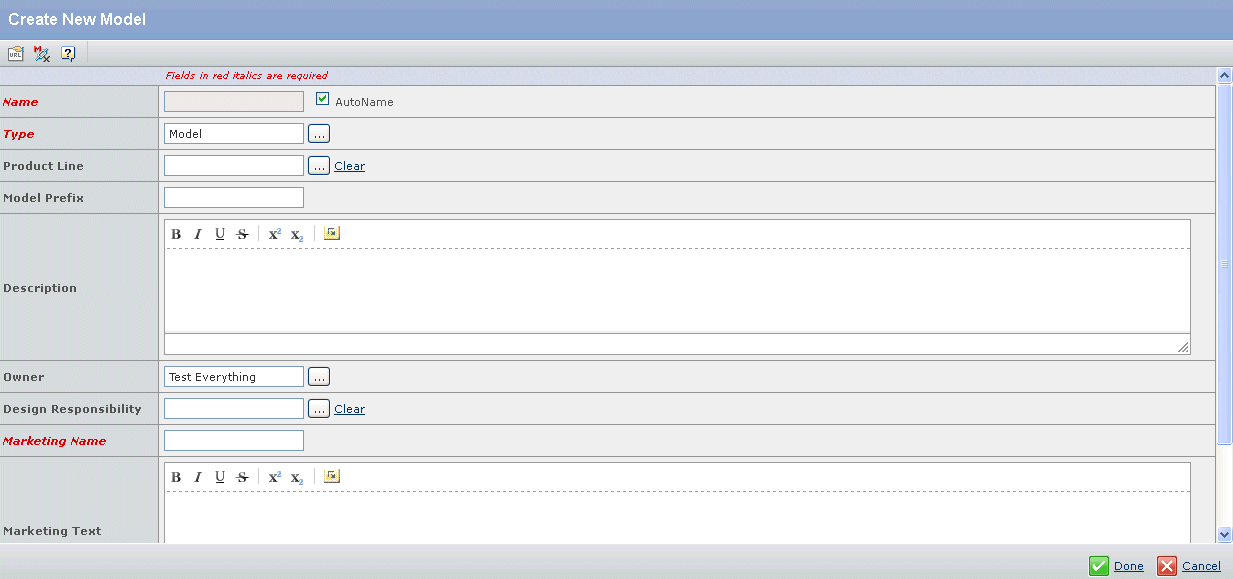To create a model,
do one of the following:
- From the Categories menu for a product line, click . For details, see Models Page. The Create New Model page opens as a slide-in window.
- From the global Actions
 menu, under Product Line, click Create Model. The Create New Model page opens as a popup window. menu, under Product Line, click Create Model. The Create New Model page opens as a popup window.

Enter details about the model, including the following:
| Field |
Description |
|---|
| Name |
Type the name of the new model or
check Autoname for the system to assign a name automatically to this model. This is a required field. Note:
Certain special characters are not allowed in names. The emxFramework.Javascript.NameBadChars property determines which characters are not allowed. See "Special Character" under Installation and Configuration > ENOVIA > Unified Live Collaboration > Studio Modeling - BPS Administration > Configuring the Properties Files > emxSystem.properties for details.
|
| Type |
Click  and select the model type. By default, the type is Model. This is a required field. and select the model type. By default, the type is Model. This is a required field. |
| Product Line |
Click  to select the product line for this model. to select the product line for this model. Note:
If you are creating the model in the context of a product line, the Product Line field is displayed in read-only mode and is populated with the name of the context product line.
|
| Model Prefix |
Type the model prefix to be inherited by all products
and product configurations created under the model. Use
alphanumeric characters. The prefix is case-insensitive. In other words, regardless of the case entered (lower or upper case), all values are converted to upper case and stored.
By default, when ENOVIA X-BOM Unit Tracking is
installed, the Model Prefix field is mandatory and must be unique. You can use a
property setting to change the Model Prefix field to not mandatory.
See the ENOVIA X-BOM Unit Tracking Administrator's Guide for details. The prefix must be unique across the database. This is to ensure that the shortform notation of the Product can uniquely represent the Product for other downstream processes. Thus, if you enter a model prefix that already exists, the error message Prefix is not available is displayed. You are prompted to enter a different prefix, and then allowed to continue. The maximum prefix length is controlled by the setting on the Model Prefix field in the Create Form. The default value is 3. |
| Description |
Type details that describe the model. Certain special characters are not allowed (see Name, above). |
| Owner |
Click  to assign an owner. By default, the person who creates the model is its owner. to assign an owner. By default, the person who creates the model is its owner. |
| Design Responsibility |
Click  to assign the design responsibility for the model to a different organization or project. to assign the design responsibility for the model to a different organization or project.Click Clear if you want to remove the design responsibility. Once design responsibility is removed, the product line becomes accessible by all Product Managers and System Engineers of the company. This change takes effect only after you click Done. If responsibility is assigned to a group to which you do not belong, you will no longer have access to the data. Note:
The design responsibility must be assigned before the product reaches the Released state. Once a product has been assigned a design responsibility, all new revisions will carry the same. Once the Design Responsibility has been set, the Clear icon is no longer available. Hence, it will no longer be possible to change this property once it has been set.
|
| Marketing Name |
This field is automatically populated with the same value as the Name field. You can accept the default or specify a different name. This is a required field. Certain special characters are not allowed (see Name, above). |
| Marketing Text |
Type the marketing text of the new model. |
| Policy |
This is a read-only field that shows the default policy that controls the model. |
Click Done.
The new model and an associated product are created; and the attributes, basics, and relationships are copied from the model to the new product. The new model is connected to the Responsible Design Organization (RDO) using the Design Responsibility relationship.
|

 and select the model type. By default, the type is Model. This is a required field.
and select the model type. By default, the type is Model. This is a required field.